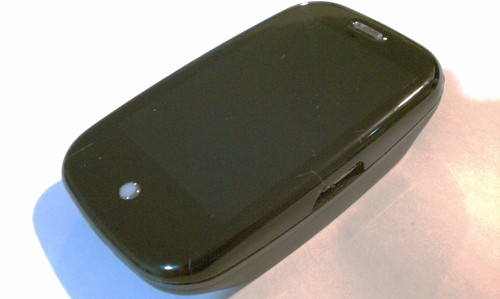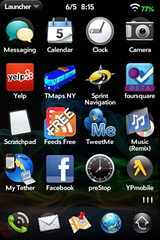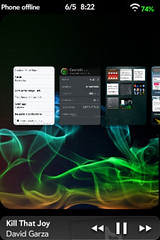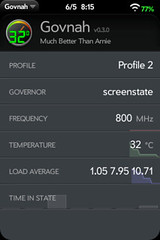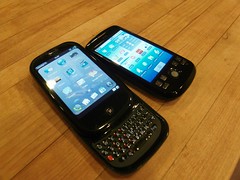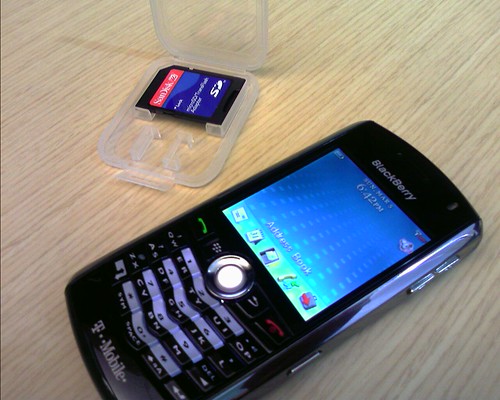I’ve spent about a week living with the HTC EVO 4G, so I figured I’d write down my initial impressions. First of all, on the whole, I’m pretty happy with the phone although there are some rough edges. The physical device is pretty solid and it’s quite capable. It’s definitely good enough (and in some cases, best of class) for day to day use. I’m also having a lot of fun poking around with it, although in some cases I find that I’m able to push things too far.
Second, before proceeding, I’ll also mention that the iPhone 4 looks great. The industrial design and overall capabilities are impressive and I believe that overall, it edges out the EVO. While I’m less enamored w/ iOS these days, iOS 4 both adds some much needed capabilities (fast task switching, backgrounding for specific services) and maintains a huge lead over the competition in terms of polish and “just workingness.” That being said, I’ve been digging Android a lot more these days. It’s amazing how far it’s come in a year. It’s definitely crossed the “actually usable” bar and it’s strengths are really coming into play. Most notably: a great security model and APIs with full access to the system allowing developers to create a much larger variety of interesting and unique apps, and its web-native paradigm (syncing to the cloud instead of the being forced to plug into a USB port and a desktop application).
Now, onto some observations. First a look at the hardware/form factor:
- The phone feels super solid. It’s got a good heft to it, but spread over a larger area, it’s not too bad.
- The size of the device is, of course, big, but because it’s relatively thin, it feels pretty good in my hands, so no real complaints there.
- There’s only 2 physical buttons: a power button on the top, and volume rocker. Both have good actuation and and very little play. I’ve noticed that when turning on the device initially, the power button is a bit fussy, but for waking up, it’s fine (well, the location could be a bit better, finger feel-wise, I have to hunt a bit even after a week). Because the buttons don’t give, I am running an app called No Lock that both gets rid of the lock screen and allows me to use the volume buttons to wake the phone.
- There’s a charging LED on the left side of the top speaker, but it doesn’t seem to be used for notifications (?). Rather, an LED lights up the bottom row of capacitive screens, which is pretty neat.
- The camera is pretty good in decent lighting. I may be convinced to carry around a macro lens…
- The capacitive button row on the are sometimes overly sensitive – I seem to accidentally trigger something fairly often. I don’t know if this is related to my specific phone
- While the build quality overall feels good (no creaks, etc), I’ve noticed (as have some others) that there’s some backlight bleed at the bottom – which in my unit is actually accompanied by some flex on the bottom corners of my unit. They’re actually very slightly elevated (not flush) with the edge and seem like they’re “popping out”, for lack of a better described. I may be annoyed enough to check if this is normal and if not, exchange it soon.
- Update: an additional caveat is that apparently, like the Incredible, the EVO touchscreen is improperly grounded. This means if you are only touching the screen (say putting it on a table or dock w/o a USB cable), it doesn’t respond to input. (I just tested it and it appears to be the case. Boo-urns.)
Some standout points:
- Battery life is so-so. About 10-12 hours with regular usage (shorter when using lots of GMaps nav, but not as bad as Sprint Navigation on the Palm, which just chewed through battery). Idle drain is about 4-6%/hr. I think it can be better (others have reported much better life), so I’m currently monitoring with JuicePlotter and SystemPanel although what I’d really like is to be able to export stats (linked w/ say the detailed battery/app use stats built into Android). I have JuiceDefender and Tasker installed, but have yet to set those up. So far, I’ve been able to be near a plug, but when I’m traveling/out and about, I tend to need 15-16hrs on a charge. There are some replacement batteries that claim 1750/1800 mAh, but those claims may be suspect. Instead, I picked up 2 generic batteries + charger for $11.49 shipped (from HK). Hopefully they aren’t too weak (still, that’s just an insane price).
- Google Maps is really good. Beyond the features, traffic and transit overlays, transit, biking, and walking routing, and of course navigation, It all navigates super smoothly, with lots of great touches (the 3D angle changes as you zoom in and out, for example). Constantly impressed using this (which I’ve been using in LA pretty much every day this week for real time traffic). If you use maps a lot, this is the gold standard.
- The voice keyboard is surprisingly useful in LA.
- Because the Android API/security model is more flexible, there are much more interesting apps. From things like call and SMS schedulers/bouncers, call graphs and analysis tools, to apps that replace default functionality, there’s just a lot of really cool stuff that integrates into the phone much more organically. Even with regular apps, thanks to intents, they extend the system functionality much more organically. I’m very impressed. Of course, w/ 2.1, app space is still limited. The EVO only has 400MB of space, and it seems to start freaking out if you start getting down to the low memory warning (40MB)
OK, and now onto general experience, etc:
- Initial setup (well, after getting the phone, after getting through Sprint’s overloaded activation system) was completely painless. My Palm Pre and Apple address book were already synced to Google’s address book, which populated on setup. Facebook, Twitter, and (an HTC addition) Flickr logins were similarly trouble free. One other note: my Sprint rep did the initial activation without taking off the factory plastic. I totally approve – the customer should get the privilege of laying first fingerprints (or screen protector) on.
- ZOMG there’s a metric crapload of bloatware on the phone (Sprint “Zones” and lots of other Sprint apps are set to load on boot). I’d also put most of the HTC Sense widgets/components in this category, although I will make an exception for their Flickr sharing add-on. It’s seriously slick. That being said, it doesn’t keep me from looking forward to installing a clean 2.2 ROM ASAP.
- It also pushed me to get a task killer. After trying out a half dozen of them, I ended up with TaskPanel. It has a fairly clean design, lets you set up an ignore and auto-kill list and has a “kill all” widget, and can be set to auto-kill on phone sleep. I also installed Startup Manager and have been removing things as I’ve been bored (it’s slow and there may be something better, but it seems to work. The latter requires root to work.
- Rooting the phone was just about the first thing I did when I got it. It’s a somewhat involved process, although relatively straightforward (alternatively, there’s a dead simple way for running root apps, but it doesn’t let you boot into recovery).
- Root also allows wireless tethering (use the latest build). This works perfectly for me on my Mac (it currently only provides sharing in ad-hoc mode, which is problematic for some devices/computers), but is also being actively made better. For example, infrastructure mode should be coming soon.
- Overall, the phone is pretty responsive, although much less smooth than the iPhone (apparently the EVO is worse in this regard). The default zoom animation also much too slow.
- The overall combination of using long-presses as a convention for menus and apps often makes functionality hidden and requires hunting, but once you get used to it, it becomes just a very low-level annoyance.
- The notification windowshade seems easier to drag, although I do admit to being a bit spoiled by being able to bring down options from the top right. Most of that functionality is replaced by the default Power Bar widget. The global notification focus stealing problems I had w/ 1.5 seem to have been fixed (at least I haven’t noticed problems while typing emails, etc. yet), but the test case I use (searching for an app while in the Market and waiting for a previously downloading app to finish installing) does still trigger this problem (causes the search box you’re typing in and everything you’ve typed to disappear). This may be localized to a single app, or single app notifications, but definitely happens.
- I dig the multiple desktops (and the expose-style viewing), although having to long-press the Home key to switch to recently used apps is much less satisfying than Palm’s cards (I would rather have an expose-style view for running apps).
- I replaced the Sense Launcher almost immediately, first with ADW.Launcher, and then with LauncherPro – both of these are much cleaner than the Sense Launcher. ADW has better (page-based) dock, and LauncherPro lets you have 5 rows on the desktop. They also both let you easily uninstall apps from desktop (hold icon over the trash can for a second), which is awesome. The dock is still fairly ridiculous, as it’s alphabetical, making it much more difficult than it needs to be to find apps you’ve just installed. What I’d really like is a way to re-order icons by recency or to have a recent bar or something. At least it remembers your scroll position now.
- While I’m on the complaining about Sense train, the call answering screen is also strangely unresponsive. While I have missed any calls, it is very disconcerting, as it doesn’t update immediately when you’ve pressed “Answer Call” so you can’t see if it’s detected your pickup or not. Not very happy with that.
- Also, being able to do your own customization means that most of the horrible Sense applications can be replaced. The keyboard I’ve replaced with Swype (the only negative being that it doesn’t have a “voice” button – Google’s system-wide voice recognition system really is magical), and there are plenty of other choices. Also, I’m using Handcent as my SMS app – it’s great, and if you follow the link, you’ll see the screenshot for what the quick response popup looks like.
- There are many options for most categories, I’ve been downloading “all” of the apps in certain categories and then culling. I had a max of about 270 apps installed, which Android just didn’t like. Trying to “manage” the apps from the system settings took forever, I was hitting the aforementioned app storage limits, and both ADW and LauncherPro started going into conniptions and frequently force closing. After some culling, I’m currently at 237 apps, and things seem to be OK. I’ll probably be only retaining one or two apps in each “category,” but worth mentioning that Android is quite happy to let you shoot yourself in the foot.
- To help manage those apps, I’m using AppBrain, which, while not perfect, at least makes installation a little less painful by allowing you to queue up items. Still, I’m basically just ignoring updates until 2.2 (auto-updating, update all) – it’s just too painful in the 2.1 Market. Also, I’m using Smart Shortcuts instead of folders on my desktop – it’s not as slick as iOS 4’s system of auto-naming, but it gives a fairly easy single interface for organizing apps. I’m not entirely happy with it as again, it sorts alphabetically, so as you add apps you lose positional muscle memory of app locations, and it’s popup animation is about 100% too slow.
- DoubleTwist is a pretty decent music player (no widget currently), but I’m most impressed by the streaming options. Here’s what my music desktop looks like currently. And of course, it’s so nice to have Shazam again.
- While I’m mentioning apps, I wanted to also mention twicca – after going through the top Twitter app contenders and spending some time with it, I have to say that (if you use a single account) it’s probably the best Twitter app I’ve used on any mobile platform. I’m very happy with it and also impressed by some of the unique features, like being able to assign actions to hard buttons (I’ve set volume up/down to jump to the top and bottom for me).
OK, in the interest of actually publishing this and getting some real work done today, I’ll stop here. I’m sure that after a couple months of usage, I’ll have some more to say. Hopefully by then, I’ll be on an AOSP 2.2 ROM. I’ll see if I can easily export an App List as well, and will probably create an EVO page to aggregate all this.
In conclusion, if you’re on Sprint and looking to upgrade, the EVO is a no-brainer. It’s far and away the best handset Sprint offers. I’ve been very happy with Sprint the past year, and their pricing, even with the $10 EVO fee remains competitive. That being said, there’s basically almost equivalently spec’d Android phones coming to all of the carriers in the next month or two (although I’m not a fan of Samsung handsets, and on GSM carriers you’re only option may be the Galaxy S). I’m actually a bit sad that Motorola is only on Verizon, as the Droid X actually looks better to me in just about every way, but them are the breaks. And of course, there’s the iPhone 4.
If AT&T works for you (that’s a big caveat in my experience if you’re in SF, NY, and to a lesser degree, LA), the iPhone I think still give you the most complete and seamless experience, and if I were making recommendations (again, with the caveat of the network), I’d continue to recommend the iPhone. On the other hand, if you’re willing to deal with a slightly rougher UX for some unique capabilities (or if you’re on a network that doesn’t have an iPhone), the Android is a perfectly serviceable competitor at this point. Some of the apps aren’t as good, but some of them are better (voice input, maps).
If you’re a geek on the fence, I would say that the choice is much more obvious. Forget jailbreaking. Apple doesn’t want you on their platform, and honestly, Android is a just lot more fun. (Palm does want you on their platform, but unfortunately just isn’t keeping up.) From all the system-twiddly apps and plugins you can get, to really compelling programmable environments like ASE, Tasker, and Locale, to all the customizations that can be done, and the vibrant modding/dev community, Android is a geek wonderland. It’s the equivalent of the hot-rod (with constant free engine upgrades) that is also now a pretty good daily driver.
